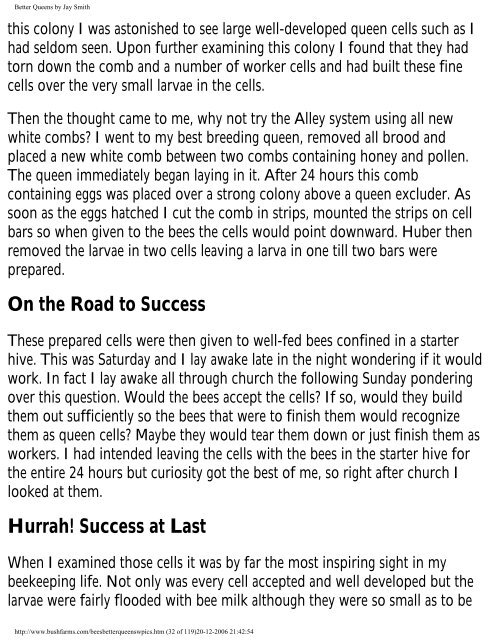Create successful ePaper yourself
Turn your PDF publications into a flip-book with our unique Google optimized e-Paper software.
<strong>Better</strong> <strong>Queens</strong> <strong>by</strong> <strong>Jay</strong> <strong>Smith</strong><br />
this colony I was astonished to see large well-developed queen cells such as I<br />
had seldom seen. Upon further examining this colony I found that they had<br />
torn down the comb and a number of worker cells and had built these fine<br />
cells over the very small larvae in the cells.<br />
Then the thought came to me, why not try the Alley system using all new<br />
white combs? I went to my best breeding queen, removed all brood and<br />
placed a new white comb between two combs containing honey and pollen.<br />
The queen immediately began laying in it. After 24 hours this comb<br />
containing eggs was placed over a strong colony above a queen excluder. As<br />
soon as the eggs hatched I cut the comb in strips, mounted the strips on cell<br />
bars so when given to the bees the cells would point downward. Huber then<br />
removed the larvae in two cells leaving a larva in one till two bars were<br />
prepared.<br />
On the Road to Success<br />
These prepared cells were then given to well-fed bees confined in a starter<br />
hive. This was Saturday and I lay awake late in the night wondering if it would<br />
work. In fact I lay awake all through church the following Sunday pondering<br />
over this question. Would the bees accept the cells? If so, would they build<br />
them out sufficiently so the bees that were to finish them would recognize<br />
them as queen cells? Maybe they would tear them down or just finish them as<br />
workers. I had intended leaving the cells with the bees in the starter hive for<br />
the entire 24 hours but curiosity got the best of me, so right after church I<br />
looked at them.<br />
Hurrah! Success at Last<br />
When I examined those cells it was <strong>by</strong> far the most inspiring sight in my<br />
beekeeping life. Not only was every cell accepted and well developed but the<br />
larvae were fairly flooded with bee milk although they were so small as to be<br />
http://www.bushfarms.com/beesbetterqueenswpics.htm (32 of 119)20-12-2006 21:42:54


